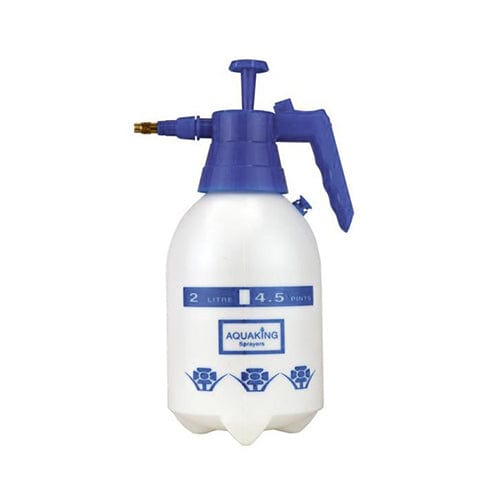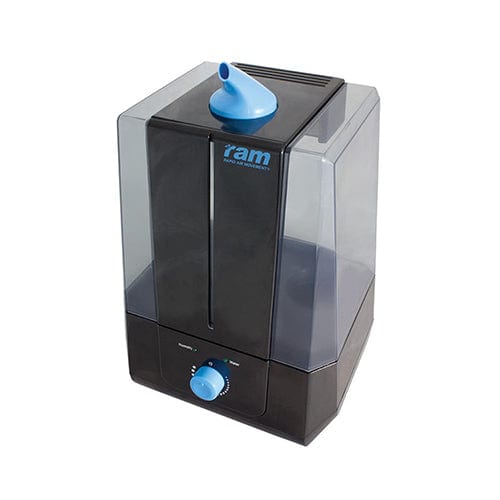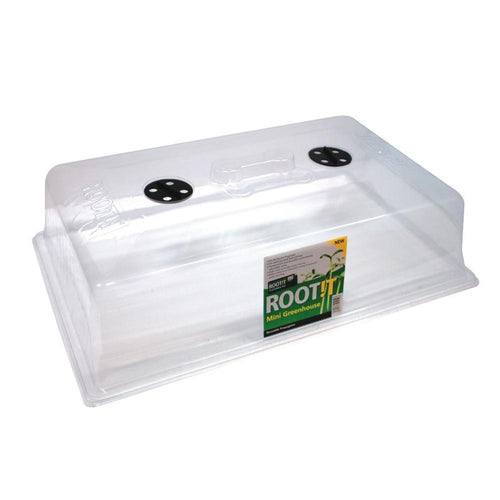How to Raise Humidity in a Grow Tent
Plants need optimum levels of humidity to ensure they maintain the correct moisture balance to prevent dehydration, wilting, disease, and rot. The beauty of growing plants indoors means that you can have total control over the grow environment. We explore the different ways of how to raise humidity in a grow tent or grow room to ensure that your plants thrive.
Why is Humidity Important for Plants?
Humidity is a term that describes the amount of moisture present in the air. Having the correct level of humidity in the grow tent is important because it affects the ability of plants to transpire, photosynthesise, and absorb nutrients.
If your grow tent is too dry, your plants will get stressed and dehydrate, impacting their ability to photosynthesis and produce energy, causing stunted growth. On the other hand, excess humidity can lead to disease, root rot and promote pests. As a result, it is very important to get the balance right to have the best chance of a successful crop and high yield.
How Does Lack of Humidity Affect Plant Health?
Lack of humidity can be detrimental to plant health. This is because plants will struggle to maintain the correct levels of moisture needed to stay healthy. Let’s take a look at some of the problems low humidity can cause.
Increased Transpiration & Water Stress
A dry grow tent can lead to increased transpiration which in turn increases stress. Transpiration serves multiple purposes such as the transport of nutrients and water around the plant, cell maintenance and temperature regulation.
The process involves the opening of the stomata on the underside of the leaves to absorb carbon dioxide. At the same time, water vapour is released into the atmosphere. As the water is diffused from the leaf cells, moisture is drawn up through the plant from the root zone.
Dry air can increase transpiration because it has a lower moisture content compared to the plant. This creates a gradient (difference in water potential) between the plant and the surrounding air. As a result, the plant may attempt to equalise the gradient by opening its stomata to allow water to evaporate into the air. This elevated level of transpiration can stress the plant and will eventually deplete the moisture within the grow media or soil leading to dehydration.
Increased transpiration can also cause a nutrient imbalance leading to deficiencies that will impact overall plant health. Lack of moisture within the soil or grow media due to increased transpiration can reduce a plant’s ability to absorb nutrients, as well as water. This can stunt growth, cause yellowing and an overall nutrient imbalance within the plant.
Another issue is water stress. Plants can get to a point where they are releasing water quicker than their roots can absorb it. This can lead to leaf curling and dehydration, even in plants grown in hydronic systems with constant access to water. For hydroponically grown plants, excess demand for water can also make the nutrient solution more potent, causing a rise in pH which can have an adverse effect on plant health.
Reduced Photosynthesis & Transpiration
Growing environments with low humidity can impact the rate of photosynthesis and can also slow the rate of transpiration. This is because in dry conditions the plant may close its stomata in order to conserve water. The closing of the stomata limits absorption of CO2 which is essential for photosynthesis.
When the stomata close, the rate of transpiration is also reduced. This attempt to conserve water can lead to heat stress. The transpiration process moves water around the plant and it is evaporated through the leaves. Reduced transpiration limits water movement throughout the plant which can result in overheating, causing damage and impeding essential biological processes. If the stomata are closed for too long, the plant can eventually suffocate and die.
We explained earlier how low humidity can increase transpiration, so it may be surprising to find that it can also slow it down. It all depends on the conditions in your grow space and how dry the air is. This is why finding the right balance is so important.
Weakened Defence
Plants grown in dry conditions are much more susceptible to stress. Stress can cause a weakening in the cell walls and deficiencies in the plant’s natural immunity and self defence mechanisms. As a result, plants can become much more vulnerable to pest infestations and disease.
Just as many pests thrive in very humid conditions, certain pests can also thrive in extremely dry conditions. Spider mites and thrips are known to prefer warm and dry conditions.
Many types of fungal disease can take hold in both dry or humid conditions. When the grow space is very dry, the weakened immunity of the plant can make it easier for a disease to take hold. Dry soil can form the perfect environment for soilborne pathogens which can cause root disease.
A weakened defence system can also make plants more susceptible to bacterial diseases.

Essentials - Digital Min-Max Thermometer
|

Aquaking Pressure Sprayer
|

RAM Ultrasonic Humidifier - 5L Tank
|
Tips to Increase Humidity in the Grow Space
During the vegetative phase you should aim for a relative humidity (RH) of around 50-70%. For the flowering stage, it is better to have lower humidity at around 40-50% to reduce the risk of moisture related problems and to promote good airflow. Our guide on the ideal temperature and humidity for plant growth explains this in more detail.
Grow lights will naturally impact humidity levels, so if you are using very hot lights, they will burn off the moisture in the air a lot quicker. Low heat lights such as LEDs will not have the same effect, promoting a more humid environment. It is important to ensure your lighting system plays a role in supporting the optimal growing environment.
Read on for more tips on how to raise humidity in the grow space to help you optimise your environment for happier plants and higher yields.
Measure Humidity Levels
The first thing you need to do is measure your humidity levels using a hygrometer. Ensure to take readings from different areas of the grow tent. The readings will help you understand how humid the space is and if you need to increase the humidity levels or not. It is important to regularly monitor levels as ever changing environmental factors can impact humidity on a day to day basis.
Spray Your Plants
A simple spray bottle filled with water can be used inside the grow tent. Spray water at the lower parts of the plant and the water will evaporate throughout the day.
Install a humidifier
Humidifiers are an essential piece of kit for any grow room. These machines diffuse mist into the air to raise the humidity level.
Most are plug and play like the Ram Ultrasonic Humidifier. All you need to do is fill the reservoir with water and switch it on. Humidifiers are available to buy with different tank sizes to suit different size tents.
Use Buckets or Containers of Water
One simple way to raise humidity within the grow space is to fill containers with water and strategically place them around the grow tent. This will increase the water surface area in the grow tent. The water will naturally evaporate to increase the level of humidity.
This is a cheap and cheerful option but you must beware of safety. Never put containers next to electrical equipment and ensure they are placed where they will not be disturbed. We recommend buying a purpose built humidifier over using this basic method.
Slow Down the Rate of Air Exchange
If your ventilation system is running too fast, it can remove essential water vapour in the air. Slowing down the rate of air exchange and circulation can help to raise humidity.

CANNA Aqua Clay Pebbles
|

Round Plastic Bucket with Handle & Lid
|

ROOT!T Propagator Lids
|
Make a Pebble Humidity Tray
Fill a tray with small stone pebbles, clean gravel or clay pebbles. Add water to the tray and make sure the level of water is no higher than the top of the pebbles. Place your plant pots on top of the tray. Over time, the water will begin to evaporate, maintaining the level of humidity in your grow space. When the water runs low, simply top it up as needed.
We love clay pebbles because they are porous and great at retaining moisture, so your humidity tray will work for longer before you need to top it up.
Use a Layer of Clay Pebbles in the Top of Your Plant Pots
Applying a thin layer of clay pebbles can slow evaporation from the grow media. Clay pebbles can also help to interrupt the lifecycle of a fungus gnat, so you can tackle two potential problems at once!
Hang Damp Cloth
Hanging damp cloth such as towels or old scraps of fabric can help. This is a cheap and easy method to increase humidity. All you need to do is soak the fabric and wring it out, then hang the fabric in the grow space, taking care to ensure it doesn’t drip onto any electrical equipment. The water trapped in the fabric will begin to evaporate due to the heat in the tent, helping to raise the relative humidity.
Cover Seedling Trays
The recommended RH for propagation is 85%. If you are propagating your seedlings in the same grow tent as your adult plants, you can place a piece of clear plastic, a propagator lid or a layer of clingfilm over the top of the tray. This will minimise the escape of moisture to keep humidity levels higher.
Alternatively, you can use a purpose made propagator that includes a tray and a lid. These are especially designed to help control humidity and air temperature.
Problems with Excess Humidity in a Grow Tent
Excess humidity can also cause a whole host of problems in your grow tent. Too much humidity can lead to stagnant air that is full of moisture – the ideal environment for disease, pests, and fungal and bacterial growth. Let’s take a closer look at how excess humidity can have an adverse effect on plant health.
Reduced Oxygen Absorption & Nutrient Uptake
Excessive moisture in the air can impact nutrient uptake. This is because the roots can become oversaturated which in turn restricts the availability of oxygen in the root zone.
It is common knowledge that plants release oxygen as a byproduct of photosynthesis but plants also need to be able to absorb oxygen through the leaves and roots to aid respiration and convert nutrients into energy when photosynthesising. It also plays an essential role in nutrient transportation. If the root zone is waterlogged, tiny gaps in the soil or grow media are filled, restricting the plant’s ability to absorb oxygen through the tiny hairs that cover the root.
What about plants that are grown in water, such as hydroponic and aquaponic systems?
If you are using a water based growing technique where the roots are always saturated, you need to ensure that the water is enriched with diffused oxygen to maintain plant health. This can be achieved in a number of ways such as by using an air stone, air diffuser, or by creating oxygen gaps to ensure roots have exposure to oxygen within the surrounding air.
Hydroponic growing techniques such as NFT (nutrient film technique), and DWC (deep water culture) are usually designed to ensure that the roots are simultaneously exposed to both the nutrient solution and air.
Problems with Transpiration
If the relative humidity in the grow space is too high, the surrounding air will not have the capacity to absorb the water vapour that your plants diffuse into the atmosphere. As a result, the water sits on the plant, unable to evaporate. This can eventually lead to rot.
Too Much Humidity Can Create the Perfect Environment for Pests
Many pests thrive in humid environments including fungus gnats, aphids and scale insects. High humidity creates the perfect conditions for pests to breed, eggs to hatch, and larvae and nymphs to develop.
Not only this, but excess humidity can also lead to fungal growth within the grow space providing a food source for pests, exacerbating pest infestations.
High Levels of Humidity Can Encourage Fungal Diseases
Fungal growth can lead to an outbreak of fungal diseases such as:
- Powdery Mildew: A common fungal disease caused by various species of the ascomycete fungi in the order Erysiphales. It is characterised by a white or grey powder on leaves and stems. This disease can cause yellowing, stunted growth and reduced yield.
- Grey Mould: Also known as Botrytis cinerea, it is characterised by its fuzzy brownish grey patches which can lead to flower or bud rot, and crop loss.
- Sclerotinia Stem Rot: A fungal disease caused by Sclerotinia sclerotiorum which can lead to white mould. This fungal disease is also known as stem rot, crown rot, and blossom blight, among others. It is noticeable by its white fluffy growths, and can lead to dark lesions, stem rot, wilting, leaf drop, and the death of the plant.
- Fusarium Wilt: This is a soilborne fungal disease caused by Fusarium oxysporum. It causes various problems such as yellowing, wilting, chlorosis, defoliation and stunted growth.
- Alternaria Leaf Spot: Also known as Alternaria Leaf Blight, it is caused by the fungi pathogen Alternaria spp. This disease is identifiable by the blackish brown spots on leaves. It affects photosynthetic capacity, and causes discoloration and defoliation.
Vulnerability to Bacterial Diseases
High humidity can make plants more susceptible to bacterial diseases such as:
- Bacterial Leaf Spot: A disease caused by several species of bacteria including Pseudomonas syringae and Xanthomonas campestris. It is characterised by its watery dark spots found on the leaves of infested plants.
- Bacterial Soft Rot: A common disease caused by various types of bacteria such as Dickeya dadantii, Pectobacterium carotovorum, and some of the Pseudomonas species, to name a few. This bacterial plant disease causes watery spots and discolouration, eventually causing decay and a foul smelling odour.
- Bacterial Wilt: Caused by Ralstonia solanacearum, it infects the vascular system, causing yellowing, wilting, and plant death.
These are just a few of the bacterial diseases your plants can suffer and die from. If the conditions in your grow environment are left unchecked, your grow tent or room can become overrun with disease, which can impact plant health, yield, and destroy your crops.
Conclusion
Controlling humidity in your growing environment is vitally important for overall plant health. Our tips on how to raise humidity in a grow tent will help you prevent many problems associated with low humidity such as dehydration, weakened self-defence mechanisms, and susceptibility to disease. Getting the balance right is essential because as we have discussed, high humidity can also cause many problems that can lead to disease, pests and destruction.
A general rule of thumb is to monitor humidity regularly and make the necessary adjustments to ensure the RH is optimised. The easiest way to manage RH is to invest in a humidifier and a high performance ventilation system. If you need more help on how to manage humidity in your grow space, get in touch for expert advice.

SHOP NOW READ MORE




